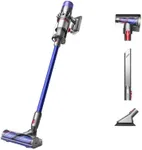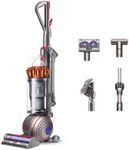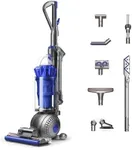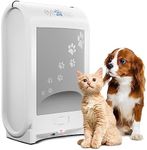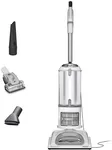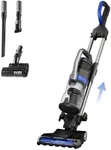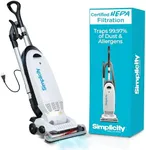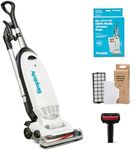Buying Guide for the Best Vacuums
When choosing a vacuum, it's important to consider the different surfaces in your home, the size of your living space, and any specific challenges like pet hair or allergies. Think about how often you'll use the vacuum, how much storage space you have, and whether you prefer something lightweight and portable or are comfortable with a heavier model. Understanding key features will help you find a vacuum that fits your needs and makes cleaning easier and more effective.TypeThe type of vacuum refers to its overall design and purpose, such as upright, canister, stick, handheld, or robot. Uprights are usually powerful and great for large carpeted areas, while canisters offer more flexibility for reaching under furniture and cleaning stairs. Stick vacuums are lightweight and easy to maneuver, making them ideal for quick clean-ups or smaller spaces. Handheld vacuums are best for spot cleaning or car interiors, and robot vacuums provide hands-off cleaning for maintaining floors daily. Choosing the right type depends on your home layout, flooring, and personal convenience preferences.
Suction PowerSuction power is the strength at which a vacuum can pull dirt and debris into the machine, usually measured in air watts or kilopascals. Greater suction helps with deeper cleaning, especially on thick carpets or when picking up pet hair. Lower suction may be fine for hard floors or lighter debris. If your main concern is dust and fine particles, especially with pets or kids around, or if you have thick carpeting, prioritize higher suction power. For mostly hard floors or minimal messes, moderate suction will suffice.
FiltrationFiltration determines how well a vacuum traps dust, allergens, and particles instead of releasing them back into the air. HEPA filters are highly effective for allergy sufferers as they capture tiny allergens. Basic foam or mesh filters are suitable for general cleaning in homes without allergy concerns. If you have asthma, allergies, or pets, look for vacuums with HEPA filtration. Otherwise, a standard filter should be adequate for routine cleaning.
Dustbin or Bag CapacityThis refers to how much dirt and debris the vacuum can hold before needing to be emptied or have its bag replaced. Larger capacities reduce how often maintenance is needed, making them ideal for bigger homes or if you clean infrequently. Smaller capacities are fine for quick, daily cleaning or smaller homes but will require more frequent emptying. Consider your cleaning frequency and the size of your space when deciding what capacity is right for you.
Weight and ManeuverabilityWeight affects how easy it is to carry or push the vacuum, especially over multiple floors or around obstacles. Heavier models tend to have more power and larger dustbins but can be challenging for some users to handle. Lightweight vacuums are easier to carry and move, making them good choices for apartments or people who may have difficulty lifting. Pick something that feels comfortable to lift and move for your typical cleaning tasks.
Attachments and AccessoriesAttachments help a vacuum tackle different cleaning tasks, such as crevice tools for tight spaces, dusting brushes for furniture, or motorized pet hair tools. More attachments provide greater versatility, especially if you have a variety of surfaces or specific cleaning needs. Evaluate the cleaning tasks you need to handle—like upholstery, stairs, or pet hair—and choose a vacuum with attachments tailored to those needs.
Noise LevelNoise level is how loud the vacuum is during use, measured in decibels. Some vacuums are much quieter than others, which can be important if you live in an apartment, have young children, or want to clean without disturbing others. Higher decibels indicate more noise, so if quiet operation matters to you, look for a model labeled as low-noise or check the sound ratings before buying.


